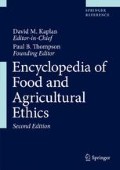Access this chapter
Tax calculation will be finalised at checkout
Purchases are for personal use only
References
Badgley, C., Moghtader, J., Quintero, E., Zakem, E., Chappell, M. J., Avilés-Vázquez, K., …, & Perfecto, I. (2007). Organic agriculture and the global food supply. Renewable Agriculture and Food Systems, 22(02), 86. https://doi.org/10.1017/S1742170507001640.
Benezra, A., DeStefano, J., & Gordon, J. I. (2012). Anthropology of microbes. Proceedings of the National Academy of Sciences of the United States of America, 109(17), 6378–6381. https://doi.org/10.1073/pnas.1200515109.
Bortenschlager, S., & Oeggl, K. (2012). The Iceman and his natural environment: Palaeobotanical results. Springer: New York.
Camacho, F. J., Gernandt, D. S., Liston, A., Stone, J. K., & Klein, A. S. (1997). Endophytic fungal DNA, the source of contamination in spruce needle DNA. Molecular Ecology, 6(10), 983–987. https://doi.org/10.1046/j.1365-294X.1997.00266.x.
Evans, H. C., & Samson, R. A. (1982). Cordyceps species and their anamorphs pathogenic on ants (Formicidae) in tropical forest ecosystems I. The Cephalotes (Myrmicinae) complex. Transactions of the British Mycological Society, 79(3), 431–453. https://doi.org/10.1016/S0007-1536(82)80037-5.
He, Y., Tian, J., Chen, X., Sun, W., Zhu, H., Li, Q., …, & Zhang, Y. (2016). Fungal naphtho-γ-pyrones: Potent antibiotics for drug-resistant microbial pathogens. Scientific Reports, 6, 24291. https://doi.org/10.1038/srep24291.
Hölldobler, B., & Wilson, E. O. (2010). The leafcutter ants: Civilization by instinct (Original ed.). New York: W. W. Norton & Company.
Kang, J.-H., Jang, J.-E., Mishra, S. K., Lee, H.-J., Nho, C. W., Shin, D., …, & Oh, S. H. (2015). Ergosterol peroxide from Chaga mushroom (Inonotus obliquus) exhibits anti-cancer activity by down-regulation of the β-catenin pathway in colorectal cancer. Journal of Ethnopharmacology, 173(Suppl C), 303–312. https://doi.org/10.1016/j.jep.2015.07.030.
Koechlin, F. (2009). PflanzenPalaver: belauschte Geheimnisse der botanischen Welt (1st ed.). Basel: Lenos-Verlag.
Milius, S. (2006). They’re all part fungus: Grass blades, coffee or cacao leaves … probably all plants. Retrieved 12 June 2015, from https://www.sciencenews.org/article/theyre-all-part-fungus.
Montgomery, D. R., & Biklé, A. (2016). The hidden half of nature: The microbial roots of life and health. W.W. Norton: New York.
Selosse, M.-A., Richard, F., He, X., & Simard, S. W. (2006). Mycorrhizal networks: Des liaisons dangereuses? Trends in Ecology & Evolution, 21(11), 621–628. https://doi.org/10.1016/j.tree.2006.07.003.
Simard, S. W., & Durall, D. M. (2004). Mycorrhizal networks: A review of their extent, function, and importance. Canadian Journal of Botany, 82(8), 1140–1165. https://doi.org/10.1139/b04-116.
Stamets, P. (2005). Mycelium running: How mushrooms can help save the world (1st ed.). Berkeley: Ten Speed Press.
Taylor, A., Flatt, A., Beutel, M., Wolff, M., Brownson, K., & Stamets, P. (2015). Removal of Escherichia coli from synthetic stormwater using mycofiltration. Ecological Engineering, 78, 79–86. https://doi.org/10.1016/j.ecoleng.2014.05.016.
Tero, A., Takagi, S., Saigusa, T., Ito, K., Bebber, D. P., Fricker, M. D., …, & Nakagaki, T. (2010). Rules for biologically inspired adaptive network design. Science, 327(5964), 439–442. https://doi.org/10.1126/science.1177894.
Trewavas, A. J. (2014). Plant behaviour and intelligence (1st ed.). Oxford, UK: Oxford University Press.
UNCTAD. (2013). Wake up before it is too late. Make agriculture truly sustainable now for food security and changing climate (Trade and environment review 2013). Geneva: United Nations Conference on Trade and Development.
Walters, D. R. (2011). Plant defense: Warding off attack by pathogens, herbivores, and parasitic plants. Oxford: Wiley-Blackwell.
Zhang, Y., Sun, D., Meng, Q., Guo, W., Chen, Q., & Zhang, Y. (2017). Grifola frondosa polysaccharides induce breast cancer cell apoptosis via the mitochondrial-dependent apoptotic pathway. International Journal of Molecular Medicine, 40(4), 1089–1095. https://doi.org/10.3892/ijmm.2017.3081.
Author information
Authors and Affiliations
Corresponding author
Editor information
Editors and Affiliations
Rights and permissions
Copyright information
© 2019 Springer Nature B.V.
About this entry
Cite this entry
Hendlin, Y.H. (2019). Fungi Ethics. In: Kaplan, D.M. (eds) Encyclopedia of Food and Agricultural Ethics. Springer, Dordrecht. https://doi.org/10.1007/978-94-024-1179-9_603
Download citation
DOI: https://doi.org/10.1007/978-94-024-1179-9_603
Published:
Publisher Name: Springer, Dordrecht
Print ISBN: 978-94-024-1178-2
Online ISBN: 978-94-024-1179-9
eBook Packages: Religion and PhilosophyReference Module Humanities and Social SciencesReference Module Humanities

